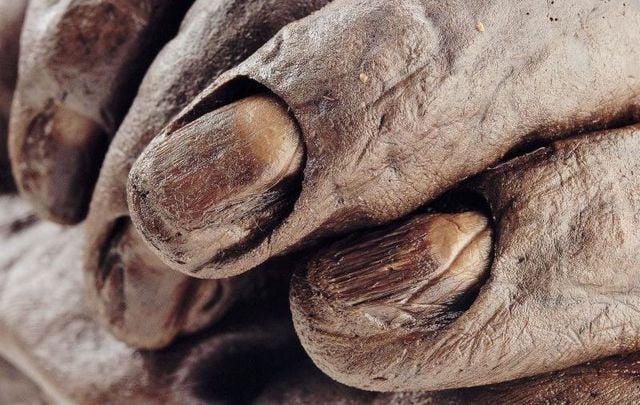The truth about Irish bog bodies

Experts tell of the violent and gruesome deaths of ancient Irish kings, but what is the truth behind these amazingly well-preserved bog bodies housed in a Dublin museum?
The first time I took my sons to the National Museum of Archaeology in Dublin was a great success. They were amazed by the hordes of ancient gold and fascinated by the Viking swords and longship. But what excited us all the most was the 2014 exhibition entitled **Kingship and Sacrifice**.
This display hosts several prehistoric bodies pulled from Ireland’s peat bogs, along with other items plumbed from the depths which may or may not be associated with them. These include gold jewelry, headdresses, weapons, eating utensils, and objects related to corn and milk production.
When the Irish decide to do something with their archaeology, it has to be said—they do it very well indeed. The mood is somber and respectful; the lighting subdued. The prehistoric past of Ireland’s kings is conjured up before our eyes with imagination and artistry, while we gaze with wonder into the faces of real people who lived, breathed, loved, and died thousands of years before us. It’s a spectacular and unforgettable experience.
### How Were These Bodies So Well Preserved?
Well, it’s all down to the unique habitat of the Irish bog. The word *bog* is derived from the Irish word *bogarch*, meaning ‘soft’. Peat bog covers 17% of Ireland’s surface, giving us the third-highest proportion of peatland in the world after Canada and Finland. It takes a thousand years to grow just one meter of bog depth.
The peat itself consists of 95% water, with the remainder made up of rotting vegetation, pollen, dust, and the like. Traditionally, peat has been cut, dried, and burned as turf in fireplaces. It is usually as a result of turf-cutting that bog bodies come to light.
The cold, acidic, oxygen-free conditions within the peat prevent decay and act to mummify and preserve the tissues of animal and human bodies.
### Irish Bog Bodies: A Mysterious Legacy
To date, around a hundred bodies have been found in Irish bogs—some male, some female, and some children. Some are thought to have ended up there by accident, perhaps falling in and drowning. Others appear to be formal (or informal) burials, while some suggest something more sinister.
Among the more famous bog bodies are:
– **Cashel Man** (discovered near Portlaoise in 2011), over 4,000 years old and said to be the oldest European bog body found with skin intact.
– **Old Croghan Man** from Co. Offaly.
– **Clonycavan Man** from Co. Meath.
– **Gallagh Man** from Co. Galway.
– **Baronstownwest Man** from Co. Kildare.
These bodies have been studied extensively using modern techniques by teams of renowned experts worldwide. Much has been discovered about their lives and the injuries that caused their deaths.
### Insights from the Bog Bodies
For example, Old Croghan Man was a giant, estimated to have stood approximately 6ft 6ins tall. His soft hands and well-manicured nails suggest he was a nobleman, supported by evidence of a diet consistently dominated by meat. He died somewhere between 362 and 175 BC.
By contrast, Clonycavan Man, about 2,300 years old, was only 5ft tall. His diet mainly consisted of grains and plants for the four months before his death; before that, he ate more meat. It is suggested he died in the autumn after a summer diet of fruits, vegetables, and grains, before a meat-rich winter diet could resume.
Interestingly, Clonycavan Man had a very distinctive hairstyle: cut 2.5 cm at the back, with the rest of his hair 20 cm long and gathered into a bunch on top. He styled it with pine resin sourced from trees only found in Spain and southern France—an expensive import indicating wealthy, perhaps noble origins.
### The Violent Deaths: Fact or Sensationalism?
According to popular press accounts, these men suffered violent and gruesome deaths. For example, Old Croghan Man had holes cut through his upper arms through which ropes were inserted to restrain him. Afterward, he was repeatedly stabbed, had his nipples sliced off, and was cut in half.
Clonycavan Man was said to have been disemboweled, struck over the head three times with an ax, once across his body, and then had his nipples removed.
Call me cynical, but these gory stories seem like attention-grabbing headlines designed to shock and attract people.
In his paper *An Archaeological Interpretation of Irish Iron Age Bog Bodies*, Eamonn Kelly, Keeper of Irish Antiquities at the National Museum, offers a different interpretation. He explains that Clonycavan Man was killed by ax blows to the head and chest, and that he had a 40 cm abdominal cut consistent with disembowelment—wounds that resemble battle injuries.
Old Croghan Man was killed by a stab wound to the chest and had a defense wound on his arm, suggesting he tried to defend himself against the attack. He was likely weaponless, then decapitated, had his nipples cut, and was cut in half at the stomach. The cuts in his arms threaded with ropes, Kelly suggests, were to fix his body at the bottom of the bog—possibly an attempt to hide evidence.
It’s unclear whether the mutilations occurred before or after death. Although gruesome, Kelly insists this was “absolutely not torture but a form of ritual sacrifice.”
### Kings and Ritual Sacrifice in Iron Age Ireland
The Iron Age king was responsible for the success of his people, ensuring fertile land, healthy livestock, and productive crops. If any failed, he was held responsible and might be sacrificed to the gods for better fortune.
Further, the king was believed to have to be whole and unblemished for his tribe to succeed. This is echoed in the mythological story of King Nuada of the Tuatha Dé Danann, who, after losing an arm in battle, could no longer remain king due to his blemish.
### A Skeptical Perspective
While I respect the experts’ work, I remain unconvinced. Archaeologists can only make educated interpretations; interpretations, no matter how intelligent, are not facts.
In my amateur opinion, the claim of ‘ritual’ sacrifice often fills gaps in understanding.
There are references in mythology reinforcing the king’s need to be whole. King Nuada is one, and another is Fergus mac Léti, King of Ulster. After a battle with a sea monster, Fergus emerged with wounds twisting his mouth to the back of his head. Mirrors were removed so he couldn’t see his deformity, as his disfigurement rendered him ineligible for kingship. Those who saw it were threatened with death if they spoke of it.
This deceit lasted seven years before the secret leaked.
### Were These Really Kingly Sacrifices?
If a king was already wounded, he was no longer whole and arguably did not require further mutilation. Why then would they sacrifice a successful king?
Perhaps these men were murdered due to ineffectual rule.
Maybe they weren’t kings at all, but rich noblemen who fell prey to robbers, plundered, killed, and dumped in bogs to hide the crime.
Perhaps they were warriors, hideously defeated in battle.
Or captives, brutally tortured.
What proof do we have that these were ritual killings rather than acts of torture or murder?
While valuable items were found nearby, ancient people have always deposited votive offerings in bodies of water; this is not unusual.
The tribes of the time were continuously battling and raiding, and mythology and history abound with such tales.
Who can say these men weren’t tortured and murdered as prisoners of war? The bog locations along ancient borders support the possibility of battlefields nearby.
### Mythology and Human Sacrifice in Ireland
In Irish mythology, the only story of human sacrifice involves a king named Tigernmas.
He set up an idol called **Crom Cruach** and ordered his people to sacrifice their firstborn children and a third of their grain to it. A 6th-century poem in the *Book of Leinster* describes this gold-covered effigy surrounded by twelve stone figures on the plain of Magh Slecht (now Moysleet) in Co. Cavan.
Children were killed by banging their heads against the stone idol, with their blood sprinkled on it.
To me, this story reeks of Christian propaganda. Tigernmas and three-quarters of his men were said to have mysteriously perished during their devotions, which Christians explained as God punishing them.
But why would a god murder those feeding him blood and grain?
Fortunately, St. Patrick arrives in the narrative, striking the stone with his crozier, shattering it, releasing a demon he then banished to hell.
Notably, this story is absent from Patrick’s own writings.
If human or kingly sacrifices were common, we would expect many such records. This appears to be the only notable one.
### The Killycluggin Stone
Interestingly, a dome-shaped stone figure adorned with La Tène style carvings was found in Co. Cavan in 1921, broken and partly buried beside a Bronze Age stone circle near Kilnavert Church, originally called Rath Slecht.
Known as the **Killycluggin Stone**, it now resides in the Co. Cavan Museum, just five minutes’ drive from where I live.
### So, What Is the Truth About Ireland’s Bog Bodies?
Unfortunately, no one really knows.
These bodies continue to fascinate us, revealing glimpses into lives long past. But the stories surrounding their deaths—whether ritual sacrifice, murder, battle wounds, or something else—remain open to interpretation.
—
*Ali Isaac lives in beautiful rural Co. Cavan in Ireland and is the author of two books based on Irish mythology:*
*Conor Kelly and The Four Treasures of Eirean* and *Conor Kelly and The Fenian King.*
https://www.irishcentral.com/opinion/others/irish-bog-bodies-truth









